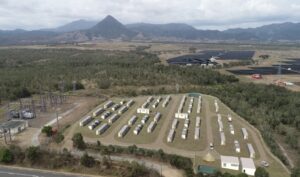When Stephen Sasse, the CEO of Australian hydroponics vegetable supplier Nectar Farms was considering building the country’s biggest glasshouse in western Victoria last year, renewables was the last thing on his mind.
“To be honest mate, the last thing I thought I would start learning about was renewable energy,” Sasse told One Step Off The Grid on Wednesday. “I thought we’d just plug into the grid and get started.”
Nearly a year later, having encountered soaring prices for grid-based electricity and gas – considered essential for heating and providing Co2 for the plants – Sasse is going ahead with the $220 million investment – but it will be powered only by wind energy, with battery storage as back-up.
Sasse says the savings from going 100 per cent renewable will be significant. Normally, around 30 per cent of the project costs would be in energy, but the wind and solar package being delivered by French renewable energy company Neoen is reducing that cost by a big margin.
“Really, why would you do it any differently,” Sasse now says. “It is cheaper for me to heat (the glasshouse) with renewable electricity rather than gas. That gives us an indication of where we are going.”
As our sister site RenewEconomy reported on Tuesday, Nectar Farms will now build a 40 hectare glasshouse near Stawell on land once owned by the recently closed gold mine. It will use hydroponics to supply vegetables to local and international markets, including the Costa food chain.
It will be accompanied by a 196MW wind farm built on the paddocks next door, and a 20MW/34MWh battery storage facility to ensure uninterrupted supply.
Together, the projects will generate $560 million of investment, provide 1,300 jobs during construction, and nearly 300 permanent jobs and another 150 indirect jobs.
Although completely ignored by mainstream media (a good case for supporting the work of RenewEconomy and One Step Off The Grid), it is an extraordinary story about the shift in technology, and in thinking about energy from industrial users.
Sasse says the traditional model for his business is to provide heat for the giant glasshouses using natural gas, and to take large amounts of electricity off the grid to meet its considerable energy needs, particularly the lighting for the plants which comes from variable spectrum LEDs.
When it became apparent that gas was either unavailable or horrendously expensive, and electricity prices were also sky-high, the company first turned its thoughts to waste energy, because it creates heat and Co2. But the Victorian government was lukewarm on that idea and more interested in the use of wind energy.
The state’s renewable energy advocate, Simon Corbell, the former ACT energy minister, became involved on behalf of the Victorian government, as did the local council, and the discussions began with Neoen only in February.
“It has been an extraordinarily efficient process,” Sasse says. “And now we have a competitive price that is significantly cent below what we would normally expect to pay.”
Now, he says, his business doesn’t need gas at all. Heat can come from heat pumps using electricity – a method recently highlighted in an ARENA report (also read here) about the alternatives to high cost gas. And there are myriad possibilities

“We are starting to get about as leading edge as we can get on sustainable glasshouses,” Sasse says. “And that is an important message in the industry of protected cropping.”
That now means that Stawell will keep a project that Nectar farms had been considering abandoning, or moving to another state, or even overseas.
Northern Grampians Shire Council Mayor Tony Driscoll says securing Nectar Farms at Stawell was a major boost for the area and would create significant jobs for the region.
“If we had not been able to negotiate this agreement between Neoen and the State Government, future expansion of Nectar Farms and subsequent jobs would have been lost to Stawell and Victoria,” he said.
“By ensuring the greenhouses have a reliable, competitive power supply, the company can grow its business here.”
Nick Aberle, campaigns manager for Environment Victoria, says it shows that renewable energy is the power of choice for business in Victoria.
“Without renewable energy this project would have been impossible. The wind farm and storage will provide low-cost, reliable energy while creating much-needed regional jobs.
“We have the potential to repower the country with sun, wind and batteries. But we need councils, governments and businesses to work together – which is exactly what we’ve seen today.”
This article was originally published on RenewEconomy’s sister site, One Step Off The Grid, which focuses on customer experience with distributed generation. To sign up to One Step’s free weekly newsletter, please click here.








